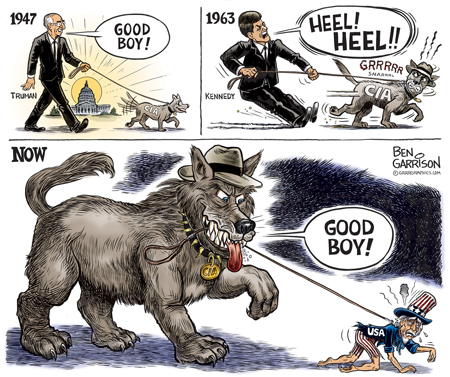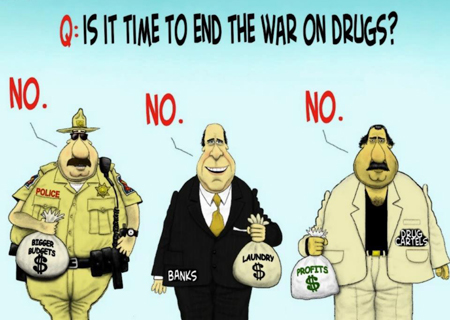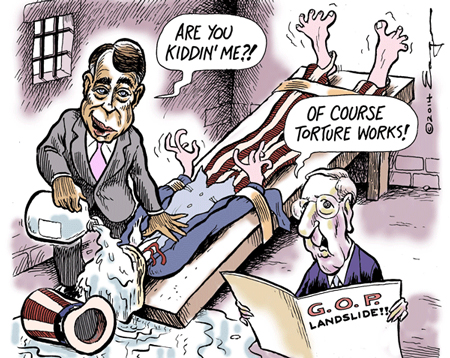The CIA: 70 Years of Organized Crime (2)
Read the first part of the article

L.S.:
Is the war on drugs also a war on blacks? Let me give you some framework for this question, because John Ehrlichman, a former top aide to Richard Nixon, supposedly admitted that: “The Nixon campaign in 1968, and the Nixon White House after that, had two enemies: the antiwar left and black people. You understand what I’m saying? We knew we couldn’t make it illegal to be either against the war or black, but by getting the public to associate the hippies with marijuana and blacks with heroin, and then criminalizing both heavily, we could disrupt those communities. We could arrest their leaders, raid their homes, break up their meetings, and vilify them night after night on the evening news. Did we know we were lying about the drugs? Of course we did.”
And I can quote from H. R. Haldeman’s diaries in this respect, of course. In the early stages of his presidency, more specifically on April 28, 1969, Nixon outlined his basic strategy to his chief of staff: “[President Nixon] emphasized that you have to face the fact that the whole problem is really the blacks. The key is to devise a system that recognizes this while not appearing to.” So, is the war on drugs that started under Nixon also a war on blacks? And if so, what does this tell us about the United States?
D.V.: America is a former slave state and a blatantly racist society, so yes, the war on drugs, which is managed by white supremacists, was and is directed against blacks and other despised minorities as a way of keeping them disenfranchised. The old Bureau of Narcotics was blatantly racist: not until 1968 were black FBN agents allowed to become group supervisors (Grade 13) and manage white agents.
I interviewed former FBN (Federal Bureau of Narcotics) Agent William Davis for my book The Strength of the Wolf. Davis articulated the predicament of black agents. After graduating from Rutgers University in 1950, Davis, while visiting New York City, heard singer Kate Smith praising FBN Agent Bill Jackson on a radio show. “She described him as a black lawyer who was doing a fine job as a federal narcotic agent” Davis recalled, “and that was my inspiration. I applied to the Narcotics Bureau and was hired right away, but I soon found out there was an unwritten rule that black agents could not hold positions of respect: they could not become group leaders, or manage or give direction to whites. The few black agents we had at any one time” he said bitterly, “maybe eight in the whole country, had indignities heaped upon us.”
Davis told how Wade McCree, while working as an FBN agent in the 1930s, created a patent medicine. But McCree made the mistake of writing to Eleanor Roosevelt to complain that prosecutors in the South were calling black agents “niggers”. As a result, the FBN’s legal staff charge McCree with using FBN facilities to create his patent medicine. McCree was fired with the intended ripple effect: his dismissal sent a clear message that complaints from black agents would not be tolerated.
In an interview Clarence Giarusso, a veteran New Orleans narcotic agent and its chief of police in the 1970s, explained to me the racial situation from local law enforcement’s perspective. “We made cases in black neighborhoods because it was easy” he said. “We didn’t need a search warrant, it allowed us to meet our quotas, and it was ongoing. If we found dope on a black man we could put him in jail for a few days and no one cared. He has no money for a lawyer, and the courts are ready to convict; there’s no expectation on the jury’s part that we even have to make a case. So rather than go cold turkey he becomes an informant, which means we can make more cases in his neighborhood, which is all we’re interested in. We don’t care about Carlos Marcello or the Mafia. City cops have no interest in who brings the dope in. That’s the job of federal agents.”
Anyone who thinks it is any different nowadays is living in a fantasy world. Where I live, in Longmeadow, MA, the cops are the first line of defense against the blacks and Puerto Ricans in the nearby city of Springfield. About 15 years ago, there was a Mafia murder in Springfield’s Little Italy section. At the time, blacks and Puerto Ricans were moving into the neighborhood and there was a lot of racial tension. The local TV station interviewed me about it, and I said the Al Bruno, the murdered Mafia boss, was probably an FBI informant. The next day, people I knew wouldn’t talk to me. Comments were made. Someone told me Bruno’s son went to the same health club as me. In a city like Springfield and its suburban neighborhoods, everyone is related to or friends with someone in the Mafia.
A few years before Bruno’s murder, I had befriended the janitor at the health club I belong to. By chance, the janitor was the son of a Springfield narcotics detective. The janitor and I shot pool and drank beers in local bars. One day he told me a secret his father had told him. His father told him that the Springfield cops let the Mafia bosses bring narcotics into Springfield and in exchange, the hoods named their black and Puerto Ricans customers. That way, like Giarusso said above, the cops keep making cases and the minority communities have a harder time buying houses and encroaching on the established whites in their neighborhoods. This happens everywhere in the US every day.
L.S.:
Is it ironic to you that the whole drug trade wouldn’t exist as it does today if the drugs were not illegal in the first place?

D.V.: The outlawing of narcotic drugs turned the issue of addiction from a matter of “public health” into a law enforcement issue, and thus a pretext for expanding police forces and reorganizing the criminal justice and social welfare systems to prevent despised minorities from making political and social advances. The health care industry was placed in the hands of businessmen seeking profits at the expense of despised minorities, the poor and working classes. Private businesses established civic institutions to sanctify this repressive policy. Public educators developed curriculums that doubled as political indoctrination promoting the Business Party’s racist line. Bureaucracies were established to promote the expansion of business interests abroad, while suppressing political and social resistance to the medical, pharmaceutical, drug manufacturing and law enforcement industries that benefited from it.
It takes a library full of books to explain the economic foundations of the war on drugs, and the reasons for America’s laissez faire regulation of the industries that profit from it. Briefly stated, they profit from it just like the Mafia profits from it. Suffice it to say that Wall Street investors in the drug industries have used the government to unleash and transform their economic power into political and global military might; never forget, America is not an opium or cocaine producing nation, and narcotic drugs are a strategic resource, upon which all of the above industries – including the military – depend. Controlling the world’s drug supply, both legal and illegal, is a matter of national security.
L.S.:
Is the CIA part of the opium problem today in Afghanistan?
D.V.: In Afghanistan, CIA officers manage the drug trade from their hammocks in the shade. Opium production has soared since they created the Karzai government in 2001-2 and established intelligence networks into the Afghan resistance through “friendly civilians” in the employ of the opium trafficking warlord, Gul Agha Sherzai. The American public is largely unaware that the Taliban laid down its arms after the American invasion, and that the Afghan people took up arms only after the CIA installed Sherzai in Kabul. In league with the Karzai brothers, Sherzai supplied the CIA with a network of informants that targeted their business rivals, not the Taliban. As Anand Gopal revealed in No Good Men Among the Living, as a result of Sherzai’s friendly tips, the CIA methodically tortured and killed Afghanistan’s most revered leaders in a series of Phoenix-style raids that radicalized the Afghan people. The CIA started the war as a pretext for a prolonged occupation and colonization of Afghanistan.
In return for his services, Sherzai received the contract to build the first US military base in Afghanistan, along with a major drug franchise. The CIA arranged for its Afghan drug warlords to be exempted from DEA (Drug Enforcement Administration) lists. All this is documented in Gopal’s book. The CIA officers in charge watch in amusement as addiction rates soar among young Afghan people whose parents have been killed and whose minds have been damaged by more than 15 years of US aggression. They don’t care that the drugs reach America’s inner cities, for all the economic, social, and political reasons cited above.
The drug trade also has “intelligence potential”. CIA officers have an accommodation with the protected Afghan warlords who convert opium into heroin and sell it to the Russian mob. It’s no different than cops working with Mafia drug dealers in America; it’s an accommodation with an enemy that ensures the political security of the ruling class. The accommodation is based on the fact that crime cannot be eradicated, it can only be managed.
The CIA is authorized to negotiate with the enemy, but only if the channels are secure and deniable. It happened during the Iran Contra scandal, when President Reagan won the love of the American people by promising never to negotiate with terrorists, while his two-faced administration secretly sent CIA officers to Tehran to sell missiles to the Iranians and use the money to buy guns for the drug dealing Contras. In Afghanistan, the accommodation within the drug underworld provides the CIA with a secure channel to the Taliban leadership, with whom they negotiate on simple matters like prisoner exchanges. The criminal-espionage underworld in Afghanistan provides the intellectual space for any eventual reconciliation. There are always preliminary negotiations for a ceasefire, and in every modern American conflict that’s the CIA’s job. Trump, however, is going to prolong the occupation indefinitely.
The fact that 600 subordinate DEA agents are in Afghanistan makes the whole thing plausibly deniable.
L.S.:
Did the U.S. employ characteristics of the Phoenix program as a replay in Afghanistan? I ask especially related to the beginning of “Operation Enduring Freedom” when the Taliban leaders initially laid down their weapons.

D.V.: Afghanistan is a case study of the standard two-tiered Phoenix program developed in South Vietnam. It’s guerrilla warfare targeting “high value” cadre, both for recruitment and assassination. That’s the top tier. It’s also psychological warfare against the civilian population – letting everyone know they will be kidnapped, imprisoned, tortured, extorted and/or killed if they can be said to support the resistance. That’s the second tier – terrorizing the civilians into supporting the US puppet government.
The US military resisted being involved in this repugnant form of warfare (modeled on SS Einsatzgruppen-style special forces and Gestapo-style secret police) through the early part of the Vietnam War, but got hooked into providing soldiers to flesh out Phoenix. That’s when the CIA started infiltrating the military’s junior officer corps. CIA officers Donald Gregg (featured by the revisionist war monger Ken Burns in his Vietnam War series) and Rudy Enders (both of whom I interviewed for my book The Phoenix Program), exported Phoenix to El Salvador and Central America in 1980, at the same time the CIA and military were joining forces to create Delta Force and the Joint Special Operations Command to combat “terrorism” worldwide using the Phoenix model. There are no more conventional wars, so the military, for economic and political reasons, has become, under the junior officer corps recruited by the CIA years ago, the de-facto police force for the American empire, operating out of more than 700 bases around the world.
L.S.:
In what form and fashion is the Phoenix program alive today in America’s homeland?
D.V.: Karl Marx explained over 150 years ago how and why capitalists treat workers the same, whether at home or abroad. As capitalism evolves and centralizes its power, as the climate degenerates, as the gap between rich and poor widens, and as resources become scarcer, America police forces adopt Phoenix-style “anti-terror” strategies and tactics to use against the civilian population. The government has enacted “administrative detention” laws, which are the legal basis for Phoenix-style operations, so that civilians can be arrested on suspicion of being a threat to national security. Phoenix was a bureaucratic method of coordinating agencies involved in intelligence gathering with those conducting “anti-terror” operations, and the Department of Homeland Security has established “fusion centers” based on this model around the nation. Informant nets and psychological operations against the American people have also proliferated since 9-11.
L.S.:
How important is mainstream media for the public perception of the CIA?
D.V.: It’s the most critical feature. Guy Debord said that secrecy dominates the world, foremost as secret of domination. The media prevents you from knowing how you’re being dominated, by keeping the CIA’s secrets. The media and the CIA is same thing.
What FOX and MSNBC have in common is that, in a free-wheeling capitalist society, news is a commodity. News outlets target demographic audience to sell a product. It’s all fake news, in so far as each media outlet skews its presentation of the news to satisfy its customers. But when it comes to the CIA, it’s not just fake, it’s poison. It subverts democratic institutions.
Any domestic Phoenix-style organization or operation depends on double-speak and deniability, as well as official secrecy and media self-censorship. The CIA’s overarching need for total control of information requires media complicity. This was one of the great lesson defeats in Vietnam taught our leaders. The highly indoctrinated and well rewarded managers who run the government and media will never again allow the public to see the carnage they inflict upon foreign civilians. Americans never will see the mutilated Iraqi, Afghani, Libyan, and Syrian children killed by marauding US mercenary forces and cluster bombs.
On the other hand, falsified portrayals of CIA kidnappings, torture, and assassinations are glorified on TV and in movies. Telling the proper story is the key. Thanks to media complicity, Phoenix has already become the template for providing internal political security for America’s leaders.
L.S.:
Is the CIA an enemy of the American people?
D.V.: Yes. It’s an instrument of the rich political elite, it does their dirty business.
Note:
According to Wikipedia, The Phoenix Program was designed, coordinated, and executed by the United States Central Intelligence Agency (CIA), United States special operations forces, US Army intelligence, special forces operatives from the Australian Army Training Team Vietnam and the Republic of Vietnam’s (South Vietnam) security apparatus during the Vietnam War.
The Program was designed to identify and “neutralize” (via infiltration, capture, counter-terrorism, interrogation, and assassination) the infrastructure of the National Liberation Front of South Vietnam (NLF). The CIA described it as “a set of programs that sought to attack and destroy the political infrastructure of the Viet Cong (NFL)”. The major two components of the program were Provincial Reconnaissance Units (PRUs) and regional interrogation centers. PRUs would kill or capture suspected NLF members, as well as civilians who were thought to have information on NLF activities. Many of these people were then taken to interrogation centers and were tortured in an attempt to gain intelligence on NLF activities in the area. The information extracted at the centers was then given to military commanders, who would use it to task the PRU with further capture and assassination missions.
The program was in operation between 1965 and 1972, and similar efforts existed both before and after that period. By 1972, Phoenix operatives had neutralized 81,740 suspected NLF operatives, informants and supporters, of whom between 26,000 and 41,000 were killed.
yogaesoteric
December 23, 2017
